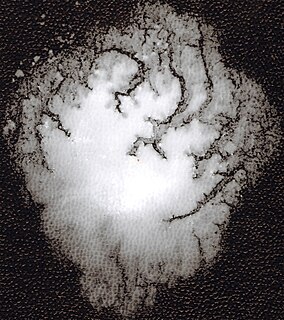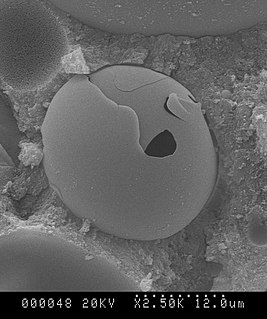
Polyurethane is a polymer composed of organic units joined by carbamate (urethane) links. While most polyurethanes are thermosetting polymers that do not melt when heated, thermoplastic polyurethanes are also available.

Polystyrene (PS) is a synthetic aromatic hydrocarbon polymer made from the monomer styrene. Polystyrene can be solid or foamed. General-purpose polystyrene is clear, hard, and rather brittle. It is an inexpensive resin per unit weight. It is a rather poor barrier to oxygen and water vapour and has a relatively low melting point. Polystyrene is one of the most widely used plastics, the scale of its production being several million tonnes per year. Polystyrene can be naturally transparent, but can be coloured with colourants. Uses include protective packaging, containers, lids, bottles, trays, tumblers, disposable cutlery and in the making of models.

A thermosetting polymer, resin, or plastic, often called a thermoset, is a polymer that is irreversibly hardened by curing from a soft solid or viscous liquid prepolymer or resin. Curing is induced by heat or suitable radiation and may be promoted by high pressure, or mixing with a catalyst. It results in chemical reactions that create extensive cross-linking between polymer chains to produce an infusible and insoluble polymer network.

Wood-plastic composites (WPCs) are composite materials made of wood fiber/wood flour and thermoplastic(s).

Syntactic foams are composite materials synthesized by filling a metal, polymer, or ceramic matrix with hollow spheres called microballoons or cenospheres or non-hollow spheres. In this context, "syntactic" means "put together." The presence of hollow particles results in lower density, higher specific strength, lower coefficient of thermal expansion, and, in some cases, radar or sonar transparency. A manufacturing method for low density syntactic foams is based on the principle of buoyancy.

Ethylene-vinyl acetate (EVA), also known as poly (PEVA), is the copolymer of ethylene and vinyl acetate. The weight percent vinyl acetate usually varies from 10 to 40%, with the remainder being ethylene.

Microcellular plastics, otherwise known as microcellular foam, is a form of manufactured plastic, specially fabricated to contain billions of tiny bubbles less than 50 microns in size. This type of plastic is formed by dissolving gas under high pressure into various polymers, relying on "thermodynamic instability phenomena" to cause the uniform arrangement of the gas bubbles, otherwise known as nucleation. Its main purpose was to reduce material usage while maintaining valuable mechanical properties. The main room for variance in these foams is the gas used to create them; the density of the finished product is determined by the gas used. Depending on the gas used, the density of the foam can lie between 5% and 99% that of the pre-processed plastic. Design parameters, focused more on the final form of the foam and the molding process afterward, include the type of die or mold to be used, as well as the dimensions of the bubbles, or cells, that classify this material as a foam. Since the size of cells is close to the wavelength of light, to the casual observer this foam retains the appearance of a solid light colored plastic.
Powder coating is a type of coating that is applied as a free-flowing, dry powder. The main difference between a conventional liquid paint and a powder coating is that the powder coating does not require a solvent to keep the binder and filler parts in coating and is then cured under heat to allow it to flow and form a "skin". The powder may be a thermoplastic or a thermoset polymer. It is usually used to create a hard finish that is tougher than conventional paint. Powder coating is mainly used for coating of metals, such as household appliances, aluminium extrusions, drum hardware and automobile and bicycle parts. Newer technologies allow other materials, such as MDF, to be powder coated using different methods. The powder coating process was invented around 1945 by Daniel Gustin US Patent 2538562.
Fusion bonded epoxy coating, also known as fusion-bond epoxy powder coating and commonly referred to as FBE coating, is an epoxy-based powder coating that is widely used to protect steel pipe used in pipeline construction, concrete reinforcing bars (rebar) and on a wide variety of piping connections, valves etc. from corrosion. FBE coatings are thermoset polymer coatings. They come under the category of protective coatings in paints and coating nomenclature. The name fusion-bond epoxy is due to resin cross-linking and the application method, which is different from a conventional paint. The resin and hardener components in the dry powder FBE stock remain unreacted at normal storage conditions. At typical coating application temperatures, usually in the range of 180 to 250 °C, the contents of the powder melt and transform to a liquid form. The liquid FBE film wets and flows onto the steel surface on which it is applied, and soon becomes a solid coating by chemical cross-linking, assisted by heat. This process is known as “fusion bonding”. The chemical cross-linking reaction taking place in this case is irreversible. Once the curing takes place, the coating cannot be returned to its original form by any means. Application of further heating will not “melt” the coating and thus it is known as a “thermoset” coating.

Fumed silica, also known as pyrogenic silica because it is produced in a flame, consists of microscopic droplets of amorphous silica fused into branched, chainlike, three-dimensional secondary particles which then agglomerate into tertiary particles. The resulting powder has an extremely low bulk density and high surface area. Its three-dimensional structure results in viscosity-increasing, thixotropic behavior when used as a thickener or reinforcing filler.
Microparticles are particles between 0.1 and 100 μm in size. Commercially available microparticles are available in a wide variety of materials, including ceramics, glass, polymers, and metals. Microparticles encountered in daily life include pollen, sand, dust, flour, and powdered sugar.

Thermal spraying techniques are coating processes in which melted materials are sprayed onto a surface. The "feedstock" is heated by electrical or chemical means.
A blowing agent is a substance which is capable of producing a cellular structure via a foaming process in a variety of materials that undergo hardening or phase transition, such as polymers, plastics, and metals. They are typically applied when the blown material is in a liquid stage. The cellular structure in a matrix reduces density, increasing thermal and acoustic insulation, while increasing relative stiffness of the original polymer.
Reaction injection molding (RIM) is similar to injection molding except thermosetting polymers are used, which requires a curing reaction to occur within the mold.

Plastic is material consisting of any of a wide range of synthetic or semi-synthetic organic compounds that are malleable and so can be molded into solid objects.
The surface chemistry of paper is responsible for many important paper properties, such as gloss, waterproofing, and printability. Many components are used in the paper-making process that affect the surface.
Expanded polyethylene refers to foams made from polyethylene. Typically it is made from expanded pellets made with use of a blowing agent, followed by expansion into a mold in a steam chest - the process is similar to that used to make expanded polystyrene foam.














